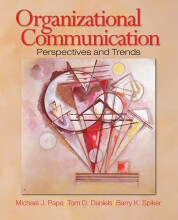Organisational Communication Structure
15 important questions on Organisational Communication Structure
What are the characteristics of the three traditional approaches to thinking about structure?
- define it as a system of pathways through which messages flow (challens perspective). misrepresents the dynamics of interpersonal communication as it objectifies messages
- the patterns of interaction among people who make up the organisaiton, the observable network, in whcih a network consists of interconnected individuals who are linked by patterned flows of information, influence and affect
- perceived network perspective: members' reports of communication reflect the latent knowledge
What is a communication network?
what is formal communication?
- Higher grades + faster learning
- Never study anything twice
- 100% sure, 100% understanding
What does downward communication entail?
- The transmission of message from upper levels to lower levels of the organisational hierarchy.
- Assumption: subordinates would accept and comply with downward communication on the basis of superiors' legitimate authority
- five type of messages: job instructions, job rationales, procedures and practices info, feedback and indoctrination
- problems: inadequate info, inappropriate means of diffusing info, filtering info and general climate of dominance and submission
- paradox of adequacy: create overload in organisation but organisational members also complain that they do not receive sufficient information on topics that are important to them
What does upward communication entail?
- transmission of messages from lower to higher levels of the organisation, initiated by subordinates with their superiors
- prerequisite for employee involvement
- may only be a token
- suggestion system needs support in order to be effective
- information is distorted so that will please superiors and reflect positively on subordinates
What does horizontal communication entail?
- the flow of messages across functional area at a given level of an organisation
- introduces flexibility in organisational structure and facilitates problem solving
- enhance morale and afford a means for resolving conflicts
- lack of commitment to decisions and conflicts over implementation arise, where members are excluded from the decision-making process
- problems occur because of territoriality, rivalry, specialisation, and simple lack of motivation
What does diagonal communication entail?
- quality circle: creating employee problem-solving groups to improve product or service quality in organisations. Positive: communication processes and patterns in the org. Effectiveness= level of connectedness x network range and extended network
- lattice design: an org. that is non-hierarchical. team members establish and commit to objectives and act to make them happen. May need to limit its size.
- heterarchical structures: self-organising non-hierarchical systems, characterised by lateral accountability and by organisation heterogeneity. Creativity and change is everyone's task.
What are the five areas of grapevine communication?
- function/extent: emerges from social and personal interests of employees, people-oriented or news
- participants: secretaries and liaisons play key roles, as they form the connection
- patterns/media: oral communication and cluster transmission
- volume/speed reliability: usually incomplete, but info is more accurate than inaccurate and diffusion is fast
- role: three types of rumours: anxiety, wish-fulfilment and wedge-driving. Rumours are distorted through sharpening, levelling and assimilation
Of which three groups does the communication network comprise?
- liaison: someone who links different groups but is not a member of any of the groups that link
- bridge: someone who links different groups and is part of the groups
- isolate: not linked to anyone, thus does not communicate
What are structural characteristics of nteworks?
- size of the network
- network density
- clustering
- stability
- conditions of membership
- connectedness
What are the advantages of a network perspective?
- allows us to tap into coupling characteristics that are difficult to see from a channels frame of reference
- help to resolve the ambiguity in distinguishing between formal and informal communication
- helps to understand the social construction aspect of organisational communication structure
What is the use of a network analysis?
- determine the degree to which emergent networks correspond with prescribed or expected channels of communication, group structures and member roles
- identify individuals in specific network roles
- determine extent of integration
- reveal correlations between network characteristics and other organisational variables
What are the two limitations of the traditional perspective according to interpretives?
- no universal agreement on the distinciton between formal and informal communication
- the concept of organisational strucutre itself may be regarded as a socially constructed reality
What are the main premises of the interpretative perspective?
- concepts such as hierarchy and grapevine are metaphors that we use to make sense of organisational communication
- in conversations that take place at work that employees construct a particular meaning of the term, which may involve acknowledgement of rules about who may talk to whom, or who has control over resources
- semantic network focus on shared menaing that people have for message content
- many opportunities for misunderstandings when there is no agreement on the crreation of shared meaning
What are the main premises of the critical approach?
- when people accept the controls associated with hierarchy, they limit choices they would otherwise make freely, but they do so to receive rewards or avoid punishment
- employees act to preserve hierarchy, guaranteeing their continued oppression, because they do not believe in an alternative
- focus on how power relationships within orgnaisaitons are sustained by the distortion
- the greater the motivation to preserve intact power structures, the greater the incentive will be to distort information
- Nowadays, flatter structure causes empowerment and exploitment of creativity
The question on the page originate from the summary of the following study material:
- A unique study and practice tool
- Never study anything twice again
- Get the grades you hope for
- 100% sure, 100% understanding































